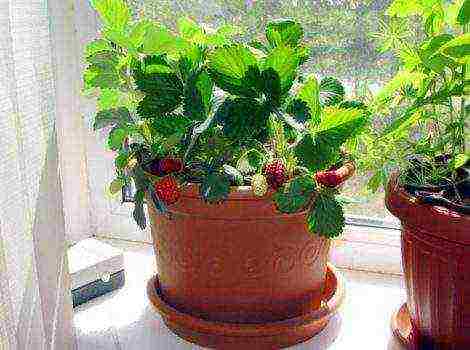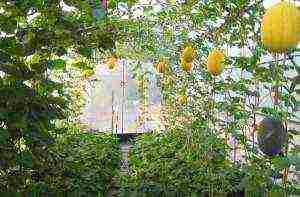Content [show]
Diet turkey meat is useful for children and adults, and especially for people prone to allergies. Poultry meat has a lot of taste advantages, and everything that is grown at home will be an environmentally friendly product and can be used for food without thinking about the dangers to health.
Growing turkeys for meat at home
Feeding turkeys
The very first food for them will be a boiled egg, carefully chopped, about 5 g per baby. For a variety of feeding, you can offer them homemade or store cheese, as well as millet. In the first three days, the chicks are fed in small portions, but often (after 3 hours) well-cooked cereal porridges. Chicks need to mix in food with grated carrots and finely chopped grass or green onion feathers, which is very useful for them as a fight against intestinal parasites. In the future, you need to observe which porridge will be eaten best of all, and that one should be offered, always mixing various greens.
Feeding turkeys
From the fourth day of the chicks' life, you can give a mash based on milk, yogurt or skim milk, adding a little cottage cheese. It is advisable to prepare it immediately before feeding so that the food does not have time to sour and disappear.
From the age of one week, babies can add more varied greens to their food. Fresh plants will serve as a vitamin complex in the diet of turkey poults, therefore, between feedings without porridge, you can give finely chopped or twisted dandelion through a meat grinder, cabbage leaves and clover, plantain or nettle, previously scalded with boiling water. Sometimes you need to add fish oil to cereals, which contains a lot of vitamins for the growth and development of poultry.
At a month and a half, turkey poults can include whole or sprouted grains in their diet. Boiled food waste or chopped apples and pears are added to the mash.
Attention! When feeding potatoes, it is imperative to remove the sprouts from it, and drain the water after the decoction of vegetables, thereby excluding poisoning and death.
Turkey diet
From two months, the diet of grown birds should include trace elements and vitamins necessary for growth, four meals a day are recommended.Along with the compound feed, alternating, you need to add corn and millet grains, yeast and bone meal, shells and chalk, and table salt should be added in very small quantities. Compound feed must be strictly poultry, you can not give feed intended for large animals, which contains a lot of salt and few nutrients. The high salt content will soon kill the bird.
If the poultry feed is difficult to access, then you need to prepare it yourself. You will need grain 60% crushed into fine grains, 25% legumes, 25% sunflower meal and 4% chalk, all this mixture will be considered mixed feed.
Advice! In the summer, prepare brooms from a set of acacia, birch, poplar and linden. You need to hang them indoors so that the birds can reach them. Also, dry broom leaves are ground and added to the mash.
From autumn to spring, 3 g per day are added to the mash, chopped needles and silage, rose hips and rowan berries to provide feed with valuable natural vitamins. Sprinkle food for chicks on a flat, level surface, such as heavy paper or waste material. Each time you feed them, you need to pour fresh clean warm water, frequent water changes contain fewer microbes and this measure will become one of the methods of disease prevention.
How and what to feed turkeys
Important! Cleanliness of feeders and drinkers will protect birds from diseases.
For babies, water should be poured into a container so that they cannot get into it. After the end of drinking, it is advisable to remove the container so that the chicks do not accidentally get wet.
The drinker for adult turkeys should be heavy and up to neck level, and the feeder, as for chickens, should be in the form of troughs or troughs. In winter, it is imperative to warm the water and pour it slightly warm into the drinking bowl.
Nipple drinkers for turkey poults
Keeping turkey poults
Rules for keeping turkeys
Small and tender chicks are very susceptible to the environment, unlike adults, so it is worth considering a few important rules:
- the temperature of the content is 33 degrees of heat from the first to the fifth day of life, 27 degrees to the tenth day and then gradually decreasing to 23 degrees;
- chicks react poorly to a sharp temperature drop and strong drafts;
- chicks do not need to be allowed out in the rain or dew until they are five weeks old. At this age, skin growths form on the necks of the chicks. Make sure that they never get wet on the street;
- avoid damaging the chicks' beak. To do this, a cardboard bedding is laid for them under food, and a solid base will damage the beak and guaranteed death;
- protect chicks from adults on a flat surface without pits, so that the kids are less injured;
- to avoid various diseases and injuries, you must not place them together with other types of chicks. Development and adaptation of turkey poults is slower than, for example, chickens.
Basic requirements for the premises
How to set up a turkey house
It is worth taking care of the previously suitable conditions for keeping, especially in the cold season, otherwise all the work on growing turkey poults will be in vain.
- In winter, you need to insulate the room as much as possible. Cover the floor with dry straw and trample it down, and when the temperature drops to -10 ° C, provide the house with an additional heater.
- In the summer period of the year, ensure the ventilation of the room (without a draft) from dampness and excess air humidity.
- Lighting in winter lasts about 14 hours a day, and additional lighting will increase the egg production of adults.
Walking turkeys
Birds love long walks, besides, they run fast, and in case of danger they can fly. Given their behavior, you need a large space in the form of a mesh enclosure or a quiet and calm environment, if there is none, you should carefully trim the wings of adults.
Walking turkeys
Attention! Restriction in a small space leads to obesity and disease in poultry.
- Walking is mandatory and will only benefit the birds. By independently obtaining food, they will receive more nutrients, and the presence of bushes or trees will protect them from the scorching sun in summer. When walking in an aviary, you need to create an artificial shade in one of the parts of the fence and take care of the presence of water.
- At the beginning of the second week of life, the chicks are released for a walk for about 20 minutes, which will be enough for the first time, given the good calm weather. With each subsequent time, the walking time increases. Monitor the weather at this time so that the chicks do not catch cold.Important! Chicks are released for full-scale walking only after the appearance of real feathers.
Chick walks are allowed after plumage
- On street walking, drinkers with water and feeders with food are placed, as well as in a buried aviary. As early as one and a half months, the birds will begin to use the nests, so they are installed indoors at a height of 45 cm and 35 cm in diameter per individual.
- It is necessary to let turkeys out for a walk not only in summer, but also in winter in calm weather at least 25 degrees, having previously spread straw on this place in order to avoid frostbite of the limbs of birds. Also, to attract them for a walk, you can lay out brooms made of dried nettles and bunches of hay for a long eating and a long walk, harvested from the summer.
Fenced turkey walk
Fattening for young meat
From four months of age, they begin to fatten to increase the weight of the turkeys. The month of increased nutrition from August to September should be held on free grazing and three meals a day, including a bag and grain crops in the diet.
How turkeys are fed
For limited grazing, feeding consists of four times per day. The food should be more flour mixture, cottage cheese, egg waste and greens, boiled potatoes and fodder beets, legumes, sprouted grains and including meat waste.
A wet mash should be prepared at the rate of: 80 gr. milk and 100 gr. flour mixing everything. Yeast and malted foods, soaked or steamed grains will help increase your appetite during weight gain.
Turkey poultry fattening diet
Show on page Open in full size
- The malted food is prepared as follows: pour one kilogram of flour mixture with two liters of boiling water and mix everything, and after two hours add the rest of the ingredients and knead until the food is loose.
- For the preparation of yeast food: take 50 g of fresh or 25 g of dry yeast for baking dissolve in lukewarm water, and then add a little 10 kg of dry flour composition, then keep it warm for six hours. Feeding lasts 45 minutes, after which the leftovers are removed and then they give root crops or useful greens. Pour a lot of water. In a separate feeder for individuals, chalk and shells should be poured.
- Of the germinated grains, wheat, oats or barley are usually used. The grain is pre-soaked and then poured onto the racks in a layer 10 cm thick. At a positive temperature above 22 degrees, the grain will germinate in three days.
What to do if birds are not gaining weight
The next month they do not walk the birds, but keep them indoors and dim the lights. They give compound feed and protein mixtures, and a mash at least twice a day. For a positive result of weight gain, one bird should eat about 800 grams of compound feed per day, and together with a mash, almost a kilogram per unit of an individual. During these months, you should provide many different grains with oats and buckwheat, which will provide sufficient protein and fat. The cake of various plants included in the diet will additionally affect the rapid weight gain of the bird and provide it with amino acids.
Caged turkeys before slaughter
Forced feeding
Pellets are prepared from a special batch: flour from corn and barley, 20% each, from wheat and add bran to 15% each, flour from oats 25% and common salt 1%.Add 5% yeast to the mixture and, per 100 g of the resulting mixture, pour 150 g of liquid of your choice, knead the hard dough. First, rolls of dough are made about 2 cm thick and 6 cm long. The finished pellet is moistened with water and placed in the bird's esophagus. With one hand, you need to open the beak of the individual, and with the other hand, lay the pellet, with a slow movement, gently press on the part of the neck from below and push it into the goiter. With this fattening, it is worth monitoring the filling of the turkey crop with food. Having increased the consumption of food, slowly begin feeding from twice a day to 30% of the food per day. With forced weight gain for an individual, the feeding period is reduced to two weeks.
Poultry machine feeding scheme
Self-feeding
Birds are allowed to graze in fields with harvested melons, cereals or sunflowers. They feed the birds two or three times right in the pasture with unlimited containers with preferably cool water. Warm water, of course, will be worse to drink, so it is worth replacing it several times a day with fresh and cooler water. It is best to equip an artificial shade on the place of walking, using the structure of a hut and a shed. With this method, large areas are needed, but the advantage is the insignificant consumption of grain crops, and weight gain is faster and better.
Fatty turkey carcasses
Reference! The older the bird is, the harder the meat and, accordingly, the worse the taste.
Fattening of adult poultry
First, it is worth inspecting the birds, you may not have to intensively feed everyone in a row. For those who need fattening when probing, the skin forms a fold, while it is very thin without fat, and the bones are sharper and strongly protrude. This can also be attributed to the average mass of birds. But a well-fed individual with rounded body shapes and palpable subcutaneous fat in the lower abdomen is already ready for slaughter. After inspection, the entire selected individual is sent to an additional set of missing kilograms. During the weight gain of young animals, it is imperative that they maintain a good appetite, peace and quiet, and given that vision and touch work well for the bird, they will pay attention to the shape and even color of food of a lighter color.
Home fattened turkey
The fattening period lasts about a month and will be the best time at the end of autumn. Fattening consists of four meals a day without walking. The composition and variety of the feed is the same as for young animals, which is dominated by a flour mixture. Adults of ordinary turkeys reach up to 12 kg, and turkeys up to 16 kg when breeding purebred birds will have different weight data.
Large turkey on the scales
Advice! During hot summer days, food intake decreases accordingly and leads to a loss of kilograms. You need to feed more vegetation and grated carrots these days, which will increase your appetite and prevent weight loss.
The secret to feeding turkey for delicious meat
- Tasty and healthy meat directly depends on a properly balanced diet, including biologically active additives and necessary for feathered matter. Compound feed with nutritious components will reduce the consumption of cereals and provide a correct, balanced nutrition for poultry.
Compound feed for turkeys
- For the successful assimilation of grain by individuals, vegetation, dried straw or hay should be added to the diet. Nuts or acorns mixed with vegetable oil or finely chopped bacon will provide juicy and tender turkey meat at the output.
- During fattening, it is worth excluding the intake of fish oil and fish meal 10 days before the end of the term, otherwise the meat will have a fishy flavor. Corn and alfalfa give the meat a yellowish hue. Oats and barley give the meat a lighter color. If it is necessary to lighten the meat at the end of feeding, give more of this grain.
Sorting turkeys and the need for fattening
In conclusion, it is worth noting that for breeding a turkey for meat, you need to monitor its diet.A variety of feed will have a positive effect on the strong immunity and health of the bird. In summer and winter, for turkeys, food must be both wet and dry. Those birds that eat what they themselves find, without human participation, of course, will not achieve much weight.
It is important to take part in the fattening of the turkey and monitor the quality of bird nutrition.
Feeding errors
Video - Feeding turkeys
Video - Breeding turkeys at home
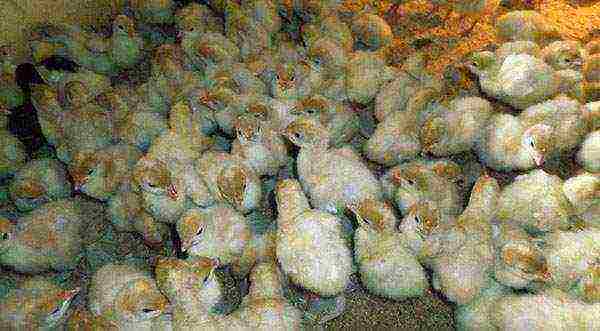 It is not for nothing that farmers call the king's bird turkey poults. Growing them at home has several benefits. Firstly, the turkey meat is dietary and extremely tasty, and secondly, the bird itself grows to an impressive size.
It is not for nothing that farmers call the king's bird turkey poults. Growing them at home has several benefits. Firstly, the turkey meat is dietary and extremely tasty, and secondly, the bird itself grows to an impressive size.
How to start growing turkey poults at home
There are several criteria by which poultry is selected for breeding. In appearance, healthy turkey poults differ from weak ones, which immediately catches the eye.
 Healthy chicks are active, clean, responsive to sound and light, the down is dry, soft, with an even coverage of the whole body.
Healthy chicks are active, clean, responsive to sound and light, the down is dry, soft, with an even coverage of the whole body.
Any draft is contraindicated for chicks, which should be taken into account, first of all, upon delivery. It is advisable to prepare the place in advance, since the high-quality maintenance of turkey poults from the first day affects their condition and further development.
The cage where small turkeys are located should be warm, always dry and with the possibility of ventilation. It is best to install a pallet to make cleaning easier and cleaner for the chicks.
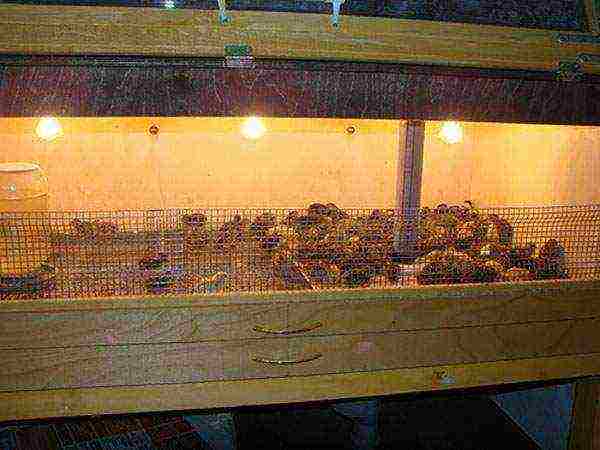 Such a dwelling is heated and illuminated with the help of ordinary and infrared lamps. After all, 3-5 day old turkeys, which are harder to grow at home than young ones, should be kept at a temperature of 33-35 degrees. When chicks are cool, they gather in heaps, try not to move, do not approach the stern, when it is hot, they can lie with open beaks and outstretched wings.
Such a dwelling is heated and illuminated with the help of ordinary and infrared lamps. After all, 3-5 day old turkeys, which are harder to grow at home than young ones, should be kept at a temperature of 33-35 degrees. When chicks are cool, they gather in heaps, try not to move, do not approach the stern, when it is hot, they can lie with open beaks and outstretched wings.
The lack of light and heat in the cage, even for the shortest period, threatens overcrowding and piling of turkeys one on top of another in search of warmth, which leads to rapid death. This is especially true for chicks from 4 to 7 days old.
There should always be a drinking bowl with clean water at room temperature and a food tray in the cage. Moreover, it is necessary to ensure that the poults do not get wet and do not trample the feed. Therefore, so that growing turkey poults at home for beginners does not seem troublesome and difficult, vacuum drinking bowls and trays with sides are recommended.
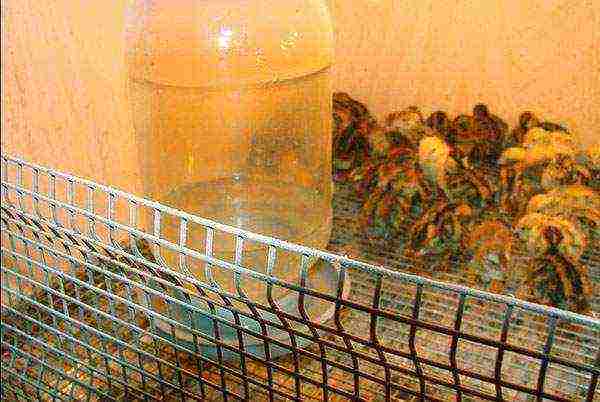 Starting from the 10th day of life, turkey poults can be transferred to a freer cage with a temperature of about 20 degrees and an open-air cage for walking in the fresh air.
Starting from the 10th day of life, turkey poults can be transferred to a freer cage with a temperature of about 20 degrees and an open-air cage for walking in the fresh air.
Proper feeding and diet
The nutrition of the chicks is a very important point. At the initial stage, when growing turkey poults at home, the diet is a combined feed with the necessary vitamins, microelements, various natural additives.
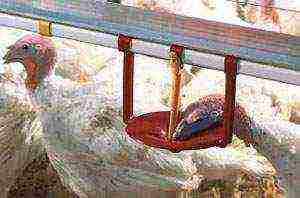 Ready-made feed should not exclude the use of chicks, especially at the initial stage, mashed cottage cheese, steamed millet, boiled eggs. Turkey poults are happy to eat finely chopped greens (green onions, bum, nettle, carrot tops, clover).
Ready-made feed should not exclude the use of chicks, especially at the initial stage, mashed cottage cheese, steamed millet, boiled eggs. Turkey poults are happy to eat finely chopped greens (green onions, bum, nettle, carrot tops, clover).
For the prevention of intestinal diseases, drinking water may contain a small solution of manganese, and for better digestion, be sure to put a separate tray with fine gravel, shells and chalk.
In the early days, the risk of death associated with improper digestion is very high. If the turkey “froze” for a long time with his eyes closed, ruffled, drooped and dropped his feathers, then he has stomach problems. It is urgent to put a pea of black pepper deeper into the beak.
In the first week, the turkey poults are poured with food every three hours, after that four meals a day are enough, with the obligatory addition of a mash to the diet.
Meshanka is a mixture of bran or chopped grain (millet, rolled oats, wheat) with herbs, sour milk.The mixture should always be fresh, crumbly and not sour. It should be given so much that the poults can cope with it within 15-20 minutes.
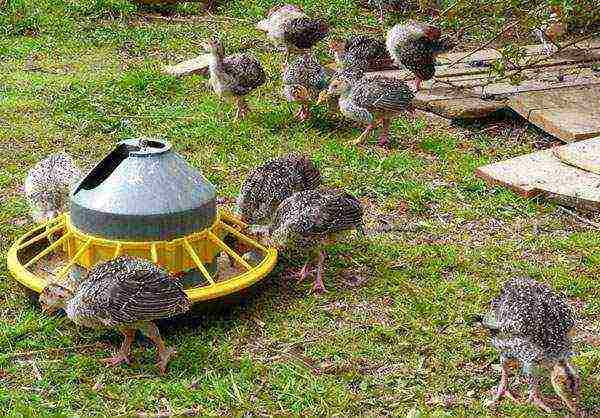 Starting from 1.5 months of age, turkey poults are fed only with dry food, herbs, finely chopped vegetables.
Starting from 1.5 months of age, turkey poults are fed only with dry food, herbs, finely chopped vegetables.
Knowing how to care for turkeys from the first days, providing them with correct and balanced nutrition, good living conditions, you can avoid unpleasant moments associated with diseases and death of chicks.
Features of walking turkey poults in an aviary
Growing poultry means having a special and free space for them to walk. Therefore, starting from 10-13 days of life, turkeys need to be released into fresh air.
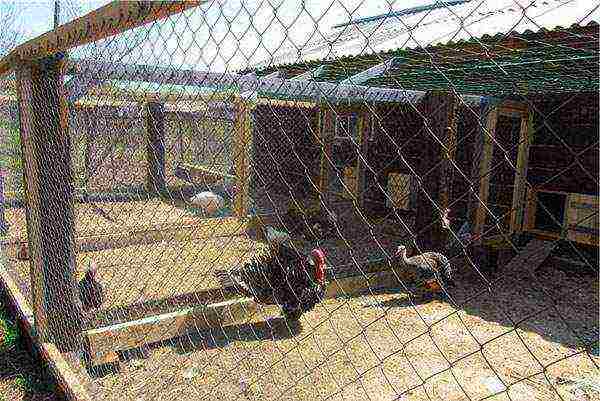 For this lesson, an aviary should be equipped, fenced and covered with a net to protect against drafts and predators. It is better if the entire territory of the enclosure is sprinkled with sand or sawdust.
For this lesson, an aviary should be equipped, fenced and covered with a net to protect against drafts and predators. It is better if the entire territory of the enclosure is sprinkled with sand or sawdust.
As with a pen, there should be water bowls and feed trays. Turkey poults, especially on warm, hot days, consume a lot of water, you need to monitor its amount.
In addition to feeders, place trays for gravel, shell, chalk in the aviary.
Heat also adversely affects the condition of the bird, they can refuse food, move little, and this leads to slow growth and weight gain. Therefore, the aviary should be equipped with several places with a canopy.
Turkey poults love to climb, take off on perches, which also need to be installed in the main pen and in the aviary.
Small home-grown turkey poults are afraid of dampness and moisture. Do not let them out into the fresh air through dew, as well as immediately after rain.
Features of temperature and light conditions
Little chicks need round-the-clock lighting. For this, the lamps are located at a distance of 1.5-2 meters from the location of the birds. In the early days, this is necessary for their full adaptation, finding feeders and trays with water.
If you arrange lamps with a blue or green tint, the bird will grow more actively. Also, for rapid growth, daylight hours, on the contrary, are extended. The use of fluorescent light bulbs will significantly reduce energy consumption.
With each day of growing up, daylight hours should decrease slightly, and eventually come down to 16 hours.
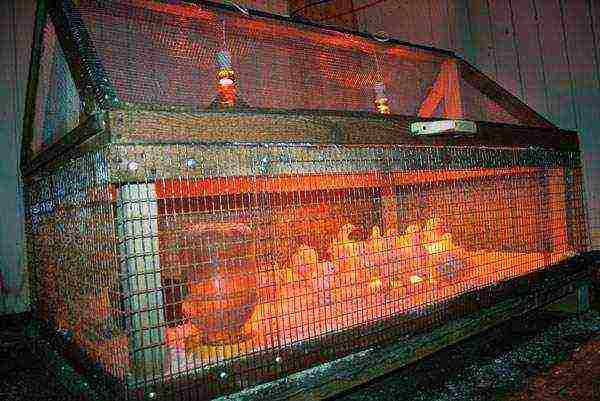 From birth, turkey poults do not know how to keep their body warm, and acquire such skills only by the age of two weeks. Ensuring correct thermoregulation is the main condition for successfully raising turkey poults at home.
From birth, turkey poults do not know how to keep their body warm, and acquire such skills only by the age of two weeks. Ensuring correct thermoregulation is the main condition for successfully raising turkey poults at home.
For the first 4-5 days, the temperature in the house or cage should be kept at 33-35 degrees, and only after 10 days can it be gradually reduced to 22-20 degrees.
In this case, incandescent lamps are located at the edges of the heated room, and not in the center. Thus, the chicks will be able to choose a more comfortable place for themselves.
Heaters are never used to keep the cage warm, nor are they installed on the sides to avoid poultry crowding to the warmer edge.
Correct cultivation of turkey poults at home (there are plenty of videos on this topic on the Internet) provides for separate maintenance from other types of poultry, in order to exclude the transmission of infectious diseases.
Features of the behavior of turkey poults
Sometimes, among turkeys, there is such a phenomenon as cannibalism. It is expressed in the pecking of both its own body and the body of its relatives.
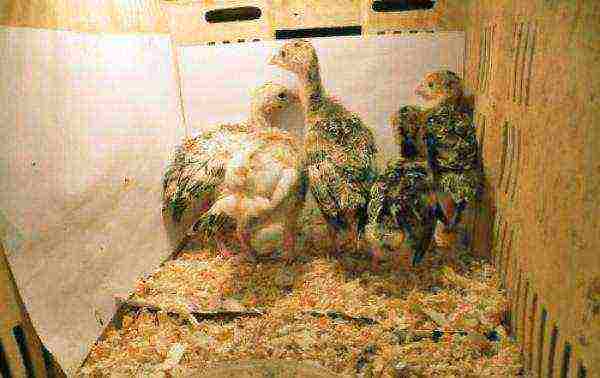 Causes:
Causes:
- dry environment in the house, lack of water;
- poor maintenance, feather parasites, insects;
- improper diet, lack or excess of protein;
- adding new turkey poults to a group of birds.
When wounds, scratches, turkey poults appear on the skin, feeling itching, they peck at the diseased surface even more, which leads to deeper wounds and damage. For this reason, many young animals die.
To avoid this, you need to know how to raise turkey poults, protecting them from such a phenomenon.
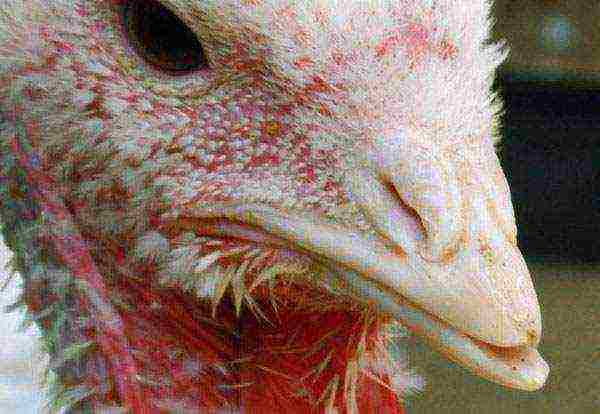 Prevention methods:
Prevention methods:
- monitor a sufficient amount of fiber in the diet of turkey poults;
- avoid crowding, providing a good walking area;
- monitor the cleanliness of the room, carry out disinfection actions before moving in;
- add abrasive substances to grind down beaks;
- keep in a bright room, avoid bright aggressive colors;
- beak cutting - only as a last resort.
Sometimes, in order to avoid the spread of mass cannibalism, it is necessary to resettle or remove the most aggressive turkey poults.
Growing turkey poults at home is the most profitable and advantageous option, it is not easy, but it pays for itself quickly. By showing maximum attention to the chicks, especially in the first two weeks of their life, you can absolutely do without serious losses and, in the end, get tasty dietary meat.
Problems of growing turkey poults - video
You won't surprise anyone with the presence of turkeys in the poultry yard now. They are grown for dietary meat. Low cholesterol levels, a range of vitamins and amino acids ensure that turkey meat is easily digestible. An adult is gaining live weight up to 20-30 kg. However, they are still not as popular as chickens or geese. Why?
The reason is that turkeys are more susceptible to disease than other poultry, in the need to provide them with a large area for walking. And the turkeys themselves are large in size. Many, especially housewives, are afraid to take care of them due to fear of being pecked by these "monsters".
This article will talk about proper care, feeding, treatment of possible diseases of turkey poults at home.
Keeping turkeys in industrial production and at home
Taking into account the fact that turkeys are a large, wide-breasted bird, their keeping at home has its own specifics. In industrial production sometimes they use the cellular method of breeding them. At home - almost always prefer walking.
Cellular way
Applies only to poultry of light breeds. This is directly related to their live weight. No more than two heads are kept in one cage. The males are separated from the females. Grow turkeys up to a maximum of 4 months of age... It is also advisable to keep young growth in cages for sale up to the age of one and a half months.
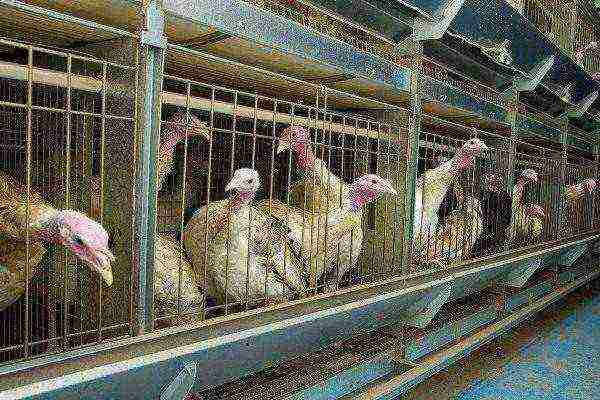 Caged turkeys
Caged turkeys
Its advantages:
- saves space due to the possibility of keeping in 2 tiers. With this method, the cages are placed along the aisles. The efficiency of using the area is doubled;
- by saving space the livestock in one poultry house can be increased by 1.7-1.8 times;
- the bird is easier to service, the labor productivity of the service personnel increases.
The disadvantages of such content are much more.... This is the reason that this method has not found widespread use:
- the intensity of growth decreases young animals after one month of age;
- reproduction is declining in males and females;
- there is a weakening of the leg muscles due to limited space. Since the bird is heavy, the muscles need periodic physical exertion;
- wings break, since their scope is large, and the area of content is limited;
- Turkeys and turkeys are more stressed, and become shy, from a sharp knock they raise a general hysteria, beat in cages and often, breaking doors, fall to the floor, receive bone injuries;
- Unnecessarily fat is stored in the liver.
Walking way
With this method of breeding, the bird feels better. It is not much different from keeping chickens or geese. Open walking and open-air cage method are used.
Outdoor walking
This is the best content option. But it requires the constant presence of a person. With this method, in the daytime, a herd of turkeys is released into the street to grazing areas unsuitable for agriculture. A slowly chased bird finds food for itself, which is not limited only to plants. Turkeys will peck almost everything that comes their way: insects, including those harmful to agricultural crops, vole mice, other small animals. When the heat comes (if walking is carried out in summer), the herd hides in the shade of trees or abandoned buildings. With the onset of puberty, males are separated from females and grazed separately. The bulk of the diet consists of grasses and grains. You can release a bird for open walking when it has reached the age of one and a half months.
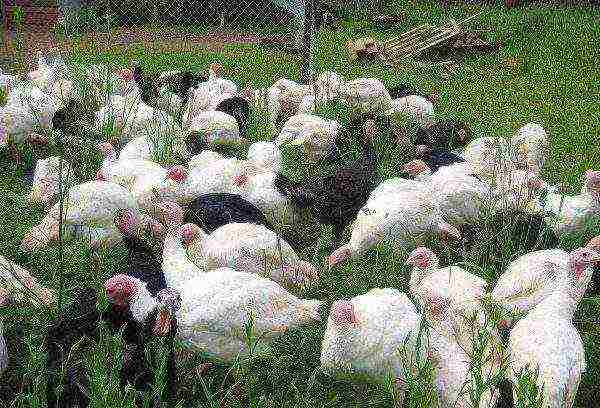 Outdoor turkeys
Outdoor turkeys
The advantages of this method of keeping:
- overall reproduction;
- disease susceptibility decreases by strengthening immunity;
- lower feeding costs by eating green mass;
- improved poultry health, since there is a daily exercise and a systematic load on the muscles;
- growth intensity increases chickens;
- not required no additional investment.
Flaws:
- with this method of walking constantly human presence is required.
Before releasing the herd for walking, the area must first be surveyed for the presence of abandoned wells, deep pits, and pesticides.
Aviary method
An aviary for turkeys is made in the same way as for keeping chickens or geese. The main difference - the size of the enclosure must be large. It is built at the rate of 10 square meters per head. I.e, to contain 20 heads, you need to fence a plot of 200 square meters.
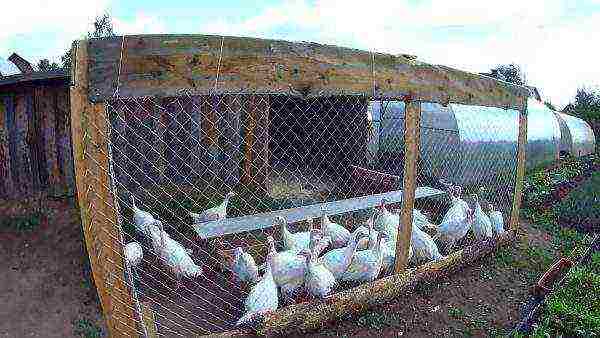 Turkey poults in the aviary
Turkey poults in the aviary
If possible, two equal sections are fenced off. They are periodically changed for grazing and walking. If there is no free area, then it is advisable to leave the walking area of 10 m2 per head, and not reduce, divide into two parts for the sake of rotation of the site. In this case, the bird is fed with freshly cut grass. During daylight hours, in hot weather, turkeys are driven either indoors, or equipped with sheds to create shade. Feeders and drinkers are also placed there.
With the walking method of keeping, it is desirable that the age difference in the herd does not exceed two weeks.
Small turkeys: how to feed and care for healthy offspring
Caring for turkeys is no more difficult than caring for other poultry. There is no need to build special premises for their maintenance. The poultry houses left after chickens and geese are used. Main condition - the room should be spacious. At a height of 70-80 cm from the floor, we install perches from thick wooden beams. At a height of 50-60 cm, we make nests for turkeys in remote places of the poultry house. Feeders and drinkers are being installed.
For offspring first we build turkey nests from hay and straw. On the bottom we put small branches to give rigidity to the shape of a wreath. If there are several nests, be sure to fence them off from each other as high as possible. We do not allow turkeys to the nests. If the turkeys have left their eggs for eating, make sure that they do not cool down. To do this, lightly cover with straw.
Turkey poults do not hatch in one day. Therefore, we remove the newborn chicks from the nest in a separate box. If necessary, illuminate with a lamp. We create the necessary microclimate using the heater, since the birth of chicks occurs in the spring, less often in the fall... After all the chicks have hatched, they are returned to the turkey.
We make sure that there are no drafts in the room, that it is light, temperature regime in summer time - not higher than + 25, in winter - not lower than +5 degrees. To lower the air temperature, we use ventilation and ventilation. To maintain warmth in winter, we insulate windows and doors. In very cold winter periods, we additionally heat the room.
Feeding turkeys, diet tables, daily allowance and proper diet
Due to the set of large live weight (up to 20-30 kg) during his life turkeys need a lot of feed... First of all, turkey poults that have just been born need a balanced diet.
In order to grow healthy offspring, you can feed ad libitum, or you can feed it according to the norms, but the normalized type of feeding is more suitable for feeding with ready-made balanced feed.
Standards for feeding turkey poults:
| Age, weeks | Feeding rate, gr |
| 1 | 10 |
| 2 | 25 |
| 3 | 40 |
| 4 | 60 |
| 5 | 75 |
| 6 | 90 |
| 7 | 110 |
| 8 | 130 |
| 9 | 155 |
| 10 | 175 |
| 11 | 200 |
| 12 | 220 |
| 13 | 235 |
| 14 | 250 |
| 15 | 260 |
| 16 | 280 |
| 17 | 285 |
| 18 | 290 |
| 19 | 295 |
| 20 | 295 |
| 21 | 300 |
| 22 | 305 |
| 23 | 310 |
| 24 | 310 |
| 25 | 300 |
| adult females | 260 |
| adult males | 500 |
In the early days
In the first hours of hatched turkey poults it is necessary to drink clean water with added glucose. After 8-10 hours day old chicks are fed with finely chopped boiled eggs. Make sure that no large lumps remain. Corn flour or wheat bran can be added to reduce moisture in the feed. It is better to put the food on a rag bed so that it draws out excess moisture. Up to one week of age turkey poults are also fed with grated low-fat cottage cheese, with the addition of a large amount of herbs to the diet: dandelion, woodlice, milkweed, finely chopped green onion feathers. Gradually we move on to feeding with mash of millet, wheat turf. Make sure that the food is not too wet. Otherwise, the turkey poults will have an upset stomach, which is dangerous at their age. We give barley and oatmeal as an independent feed. At such an early age, food for turkeys is given at intervals of every three hours. For the mash we make a separate feeder, for dry food there should be one. We make sure that there is constantly fresh water in the drinkers.
From one week to one month old
During this period, turkey poults grow intensively and gain weight.... They are active, run, willingly eat whatever they are given. We gradually increase the share of green mass in the total composition, bringing it to 30% of the total feed. Greens can be finely chopped by mixing with dry food. They also give pure greens. Better during this period to feed a balanced composition of feed. At two weeks of age add chalk, bone meal to the feed. Add potassium permanganate to the water so that the solution is not pink. During this period, the poults are fed every 4 hours. With good feeding, by the age of one month, the young gains up to two kilograms in weight.
We introduce new feeds into the diet gradually. Their share should not immediately exceed 15% of the total mass.
From a month to two
During this period, young animals are fed only three times a day. This is due to the fact that their activity decreases. In order not to accumulate fat, stop adding compound feed to the diet.... The main emphasis is placed on grain and grain waste, green mass, bran, crushed corn, dry residues of animal origin. Give wet mash, increasing the amount of protein feed: minced meat from meat waste or inexpensive fish, etc. By the onset of hot weather, turkeys reach two months of age and gain a decent mass.
After two months before slaughter
The diet during this period of life does not differ from the previous one. We increase the share of grain and grain waste in the total mass... We transfer the bird to a walking method of keeping. It is described above. Adult turkeys for reproduction are kept up to two and a half years old, turkeys for breeding chicks - up to three years old. If the goal of growing is the sale of meat, it is advisable to fatten the livestock up to five months of age. With the onset of autumn, the natural growth of herbs decreases. For replenishment it is necessary to increase the proportion of grain. The economic effect of growing is decreasing.
Feeding rations
Sample rations for feeding turkeys are shown in table. 1-3.
Table 1. Approximate ration for feeding turkeys, g per head per day (1st option)
| Stern | Age, days | ||||||
| 1-5 | 6-10 | 11-20 | 21-30 | 31-40 | 41-55 | 56-70 | |
| cottage cheese | 3 | 10 | 10 | 10 | — | — | — |
| curdled milk | 20 | 20 | — | — | — | — | — |
| corn grits | 40 | 38 | 20 | 20 | 10 | — | — |
| wheat | 15 | 20 | 30 | 30 | 30 | 35 | 25 |
| barley | 12 | 14 | 21 | 21 | 27 | 30 | 35 |
| millet | 10 | — | — | — | — | — | — |
| penny bran | — | — | 20 | 20 | 15 | 15 | 15 |
| fish flour | 12 | 15 | 10 | 10 | 13 | 14 | 20 |
| meat and bone meal | 5 | 5 | 2 | 5 | 5 | — | — |
| oats | — | — | — | — | 10 | 30 | 30 |
| wheat | — | — | 10 | 10 | 20 | 15 | 20 |
| crushed corn | — | — | 10 | 10 | — | — | — |
| barley | — | — | — | — | 20 | 15 | 40 |
| greens | 5 | 30 | 60 | 50 | 70 | 100 | 100 |
| shell, chalk | 2,5 | 2,5 | 2,5 | 3 | 3 | 4 | 4,5 |
| fish fat | 2 | 2 | 2 | — | — | — | — |
| salt | 0,1 | 0,2 | 0,3 | 0,5 | 0,7 | 0,8 | 1 |
Table 2. Approximate ration for feeding turkeys, g per head per day (2nd option)
| Feed | Age, days | ||||
| 1-5 | 6-10 | 11-20 | 21-30 | 31-40 | |
| boiled egg | 2 | 1 | — | — | — |
| skimmed milk | 5 | 10 | 10 | 15 | 10 |
| fat-free cottage cheese | 2 | 5 | 10 | 5 | — |
| whole grain (corn) | 5 | 7 | 152 | 208 | 3015 |
| wheat bran | 4 | 5 | 8 | 12 | 15 |
| cake | — | — | — | — | 5 |
| greens | 3 | 10 | 15 | 20 | 30 |
| shell, chalk | — | 0,5 | 1 | 1,5 | 3 |
| total | 21 | 38 | 61 | 81 | 108 |
Table 3. Approximate ration for feeding turkeys, g per head per day (3rd option)
| Stern | Age, days | |||||||||
| 1-5 | 6-10 | 11-15 | 16-20 | 21-30 | 31-35 | 36-40 | 41-50 | 51-60 | 61-70 | |
| grain of two types | 5 | 8 | 20 | 30 | 50 | 60 | 80 | 15 | 145 | 175 |
| wheat bran | 4 | 5 | 5 | 10 | 10 | 10 | 15 | 15 | 25 | 25 |
| fresh greens | 3 | 10 | 15 | 20 | 30 | 40 | 40 | 40 | 100 | 100 |
| return | 5 | 10 | 10 | 15 | 10 | — | — | — | — | — |
| cottage cheese | 2 | 10 | 10 | — | — | — | — | — | — | — |
| boiled egg | 3 | — | — | — | — | — | — | — | — | — |
Diseases of turkeys: symptoms, treatment and prevention of diseases
In the process of life, turkeys need not only a room, food, but also protection from disease.
The main ones are:
- Smallpox: an infectious disease, manifested in the refusal of the bird to eat and drink, turkeys become inactive, feathers ruffle, wings hang down. Infected from other sick birds, flies, mosquitoes. Infected individuals should be destroyed and burned, and healthy ones should be vaccinated with an embryo vaccine. As a prophylaxis, turkeys in the sixth week of life are vaccinated with this drug.
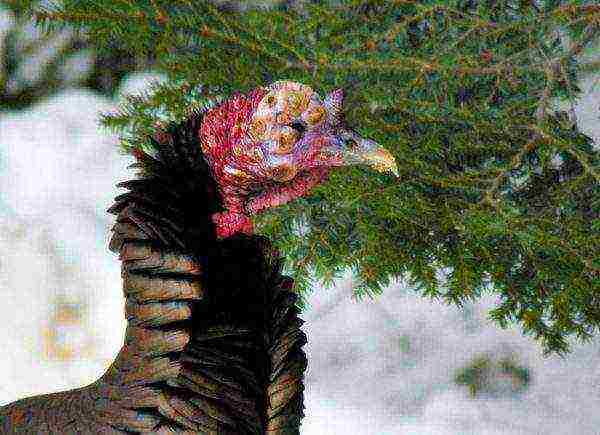 Smallpox in turkeys
Smallpox in turkeys
- Worms: pests that settle inside the individual, affecting the digestive organs and respiratory tract. The bird begins to lose weight. Sources of infection: soil, other infected poultry, feed. Control methods: use of piperazine sulfate, phenothiazine. Preventive measures: processing of the premises with sanitary and hygienic means.
- Respiratory mycoplasmosis: bacteriological disease covers the respiratory tract, the mucous membrane of the eye becomes inflamed. Turkeys lose their orientation, walk, staggering. Individuals may die without treatment. The disease infects healthy birds through contact with sick birds. The occurrence is facilitated by a decrease in immunity due to unbalanced feeding and improper maintenance (hypothermia of individuals, high humidity and dirt in the room). Ways to fight: chlortetracycline or oxytetracycline is added to the diet for a week at the rate of 4 grams per 10 kg of feed. Antibiotics erythromycin, chloramphenicol and streptomycin are also saved. Prevention: balanced nutrition, the room is kept clean, constant ventilation.
- Tuberculosis: the most dangerous disease due to the scale of the defeat of the livestock. All respiratory organs are affected. The bird practically does not eat, sits in one place, vilifies. Dirty water is the source of infection.inventory and bedding infected with tubercle bacillus. It is recommended to urgently destroy the infected bird. The best way to fight - the presence of direct sunlight and fresh air. The house is left unoccupied and open. The livestock is transferred to another location.
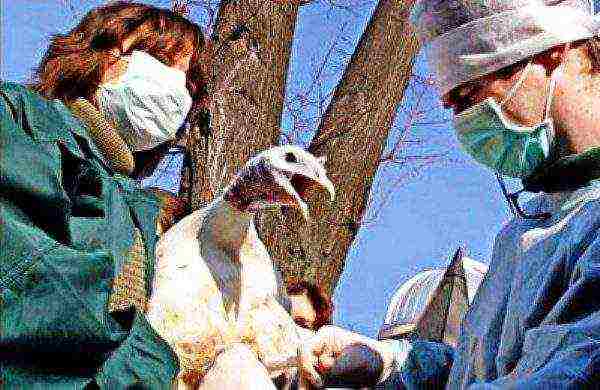 Veterinarian examining a turkey
Veterinarian examining a turkey
- Histomoniasis: the cecum in birds and other digestive organs are affected. Symptoms: turkeys begin to vilify, rapidly lose their weight. It is urgent to separate the infected bird from the healthy one. The room is cleaned and disinfected. Furazolidone, osarsol or phenothiazine are added to the feed. The cause of the disease - in a dirty room and lack of disinfection after the previous inhabitants.
- Hard goiter: the reason lies in an unbalanced diet, the composition of which is limited to solid food. It is necessary to add chalk, pebbles of gravel and shells to the diet so that the grain in the crop is better processed. The poultry is slaughtered for meat. It is not contagious.
- Hypovitaminosis: in sick birds, eyes become inflamed, rickets develops. The body lacks vitamins... When the disease appears, injections are made from a complex of vitamins.
- Diarrhea: the cause of the occurrence is viral diseases, direct contact with parasites, as well as the consumption of foods of insufficient quality. If the diarrhea is brown, then some food product is not suitable for young turkeys. If the color of the excrement is white - these are signs of an infectious disease of pullorosis. Ways to fight: drinking chamomile decoction or potassium permanganate solution, if this does not help, they are treated with antibiotics.
- Diseases of the feet: occur due to the keeping of birds in a confined space (in cages, small poultry houses). It manifests itself in the fact that sick turkeys fall to their feet. Another cause of the disease is a lack of calcium-containing foods in the diet. Prevention: egg shells, chalk, shells are added to the feed, less soybeans, fats, a limited amount of corn. Arthritis in turkeys occurs as a result of an overabundance of protein in the feed.
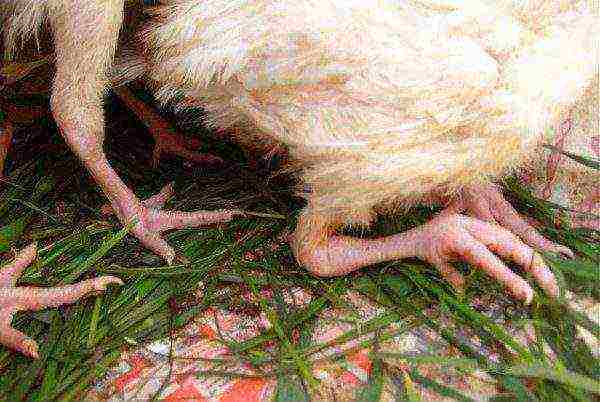 Leg diseases in turkeys
Leg diseases in turkeys
- Newcastle disease: infection. The result is paralysis of the lower extremities. Vaccination is carried out against this disease. But it does not always help. Prevention: adding mineral and vitamin supplements, fresh herbs, cottage cheese (for turkey poults) to the diet.
- Runny nose (rhinitis): its main causes are hypothermia, lack of vitamins. The exceptions are vitamins A and D. Also, the cause of rhinitis in turkeys can be a poorly ventilated room in which they are kept. Treatment and prevention: there are cases when a runny nose in turkeys quickly passes if they are placed in a warm, dry room and continue the treatment of turkeys with infusion or decoctions of dill (seeds). You can also give them an infusion made from violets, or from the leaves and berries of strawberries. But it is recommended to wipe the beak and nostrils with a feather soaked in salt water. For this solution, you need to take a glass of water and one teaspoon of salt. After this procedure, you should smear the beak with boron fat.
Turkey farming as a business is still underdeveloped. But after all together with dietary meat we get an egg, fluff, feather... With a competent approach to business, a dozen heads of such a bird will be enough to provide a family with meat and its sale in order to compensate for material costs. An increase in livestock leads to a good net profit.
Turkeys are beautiful and majestic animals ideal for keeping on a home farm. However, breeding, keeping and caring for turkeys is a headache for many novice poultry farmers. How to breed turkeys correctly?
Turkeys: breeding, maintenance, care at home
The most famous breeds for breeding
If you have chosen turkeys as a breeding bird, the first thing you need to do is decide on the breed. They usually choose it in accordance with the goals, method of content and personal desire. Before buying individuals, you need to learn how to navigate the characteristics and main features of the chosen breed - this is the only way to organize proper care. In Russia, several of the most common breeds are distinguished.
|
Bronze |
Red and brown striped feathers, black necks in males. Females are more modest in color. They are good for keeping in the fresh air, they do not require special conditions. | 13 | 7 | up to 100 |
|
Moscow bronze |
Hardy individuals intended both for breeding in production conditions and for a home farm. Relief chest, elongated torso. Feel good when grazing. | 15 | 9 | 100 |
|
Bronze broad-breasted |
In appearance they are similar to their bronze ancestor, but larger and larger in the body. Low egg production, inability to walk. Are intended more for industrial content. | 14 | 8 | 70-80 |
|
North Caucasian bronze |
They first appeared in the USSR, in 1946. One of the most common breeds for growing at home. Large birds adapt well to any conditions. | 14 | 7 | 80 |
|
White broad-breasted |
Oval body with a large chest and a broad back. They are characterized by rich plumage, strong legs. Grown for healthy dietary meat and eggs. | 15 | 7 | 100-120 |
|
North Caucasian white |
Hardy birds with good performance and quick weight gain. They are well kept in pasture conditions, not picky about food. | 13 | 7 | up to 180 |
Read also: Turkey breeds
Negative and positive aspects of breeding
Home farmers are increasingly opting for turkey farming. Some breed turkeys for personal consumption, some make a profit from the sale of meat and egg products. Either way, turkey breeding has its advantages and disadvantages. Before deciding whether to do this business, you need to know them.
Bronze broad-breasted turkey
The advantages of content are the following:
- dietary turkey meat is very useful for humans, all thanks to low cholesterol, vitamins, amino acids and trace elements;
- the cost of a turkey growing business quickly pays off;
- for the purpose of earning money, you can sell not only meat and egg products, but also down, feathers;
- turkeys gain weight quickly and rapidly;
- undemanding to conditions of detention and unpretentiousness to nutrition.
Turkey meat is considered dietary
Turkeys are excellent pets for keeping at home and running a business selling meat, eggs, fluff. But some breeders refuse to keep turkeys. They justify this with the following disadvantages of keeping turkeys:
- low productivity - turkeys produce much fewer eggs than chickens;
- the risk of death of chicks after birth;
- demanding for water - use only fresh liquid at room temperature;
- turkeys are often sick, especially if hygiene rules are violated when caring for them;
- the tendency of turkeys to obesity.
Obesity turkey
The note! Turkeys first appeared in America, domesticated them about a thousand years ago. Europe saw birds only in the 16th century.
Features of turkey care
Turkeys are unpretentious animals that can withstand cold temperatures down to -15 ° C, but they still prefer dry and warm care. Make sure that the pen is not damp and that there is always warm bedding on the floor - you need to keep the legs of the turkeys warm. Change the bedding at least twice every seven days. Equip each paddock with small boxes of sand and ash to prevent parasites.
Ash bath for birds
You should especially carefully approach the issue of caring for young animals. Provide chicks with a dry and warm place for the first time. For these purposes, you can use a cardboard box or box. In a temporary dwelling, the temperature must be at least 36 degrees, in addition, it must be constantly illuminated. When the chicks mature, you can move them to a common stall. When arranging a nest, you need to raise its walls high, isolating the hen from other individuals.
Turkey nest
Read also: DIY turkey nest
Requirements for the premises
Experienced livestock breeders have specific room requirements for comfortable keeping and profitable turkey breeding. To set up a comfortable house, follow the instructions below.
Step 1. Decide on the size of the room. The correct calculation is as follows: at least 1 m2 for two turkeys. Ideally, there should be 1 m2 per individual.
Turkey house on a small flock of birds
Turkey house project for 15-30 heads
Step 2. When the house is set up, check the room temperature. The acceptable temperature in summer is 20 ° C, in winter it is no colder than 5 ° C.
Step 3. Adjust lighting. You can illuminate the poultry house with a conventional 60-watt light bulb.
Lighting in the poultry house
Step 4. Be sure to equip ventilation, this will help eliminate dampness.
Step 5. Equip the perches according to the number of birds in the pen (one perch per bird), the distance between them is 60 cm or more.
Step 6. Check the height of the perches. Correct indicators: about 70-80 cm from the floor, width - from 5 to 7 cm, height - from 8 to 10 cm.
Turkey roosts
The note! If you keep all individuals in the same pen, the flock should be no more than 5 females per male, otherwise not all hens will be covered.
Do turkeys need walking?
Turkeys are prone to obesity, so they need to spend enough time walking.While walking, the bird eats useful food, finds worms, beetles, eats greens, seeds and nuts. The ideal place for walking in summer is dry ground with shrubs and green grass. Make sure that the bird can find shade and hide there from the heat. For walking turkeys, you can equip special outdoor enclosures. Install feeders with oats and barley, drinkers, and change the water regularly.
Walking for turkeys
It is especially important to walk the turkeys during the winter - take daily walks for several hours, but not in too windy weather. Cover the area with plenty of straw to keep the turkeys from freezing their feet. You should also scatter food to lure pets out for a walk. If there are too many turkeys, divide the herd into small groups (each with one breeder).
Organization of walking turkeys
Breeding turkeys
Experts recommend for beginners to start breeding with grown young individuals. The best option is three or four month old individuals. By this time, they get used to the classic food, and their immunity is getting stronger. When breeding from scratch in the house, it is necessary to have individuals of different sexes. One male - for 8-10 females. If there are more of them, the male will not be able to properly perform his duties.
North Caucasian silver turkey and turkey
Female eggs incubate for about a month. The bird should be rooted in the spring. Ideally, there are about 17 eggs under one turkey, and all are freely located under the female. Under an inexperienced turkey, which became a mother for the first time, it is better not to lay a large number of eggs. At the very bottom of the nest, place a thin layer of earth, and put dried straws on top. Put the nest in an isolated place, put a drinker and a feeding plate with food next to it.
The note! Female turkeys can raise about 80 babies. A turkey is able to hatch even other people's chicks - chickens or ducks.
Hatched chicks
Using incubators and brooders
Turkeys are wonderful mothers who hatch responsibly and then raise and protect their offspring. Sometimes they give themselves up to their duties so much that they forget to eat - in this case, forcefully remove the hen from the nest and take it to food. While the turkey is feeding, you can inspect the eggs for scratches or dents. After hatching, it is recommended to immediately add the babies to the hen and keep them with the mother for about 6-8 weeks.
Bronze turkey with chickens
On a home farm, you can use an incubator. Eggs that are intended for incubator rearing must be removed from the poultry and transferred to storage. Place eggs on the tray with the pointed end downward - this saves a lot of space. From the moment the eggs are placed in the incubator to hatching, it takes about 28 days. Up to 22 days inclusive, turn the eggs 12 times a day so that they warm up evenly. You should also observe a strict temperature regime.
| 1-3 | 37,8-38 | 29-29,5 | closed |
| 6-12 | 37,6-37,8 | 29-29,5 | ajar 15 mm |
| 13-25 | 37,5-37,6 | 28-28,5 | ajar 15 mm |
| 26 | 37,2 | 29-30 | ajar 20 mm |
| 27 | 37-37,2 | 30-33 | ajar 20 mm |
| 28 | 37 | 35 | ajar 20 mm, open completely 3 hours before sampling |
Setting eggs in the incubator
Video - Turkeys: breeding and maintenance
In the video, an experienced livestock breeder tells the audience where the turkeys came from in Russia. You will learn how to organize the keeping of a bird from egg to adult. The video covers the incubation process, as well as the main issues of care and maintenance. You will also see how to properly equip an aviary and how animals behave while walking.
Nutrition for proper and complete growth
To successfully raise turkeys on a home farm, feed them properly. In most cases, poultry farmers use a combined type of food. Feed the birds with sprouted grains, dry or damp mash. In the fall and spring, take your pets for walks in the pasture so that they can feast on the greens.Use vitamins and food: add chopped carrots, chopped cabbage and beets. Food can be diluted with dried, steamed herbs.
Turkey feed recipes
Turkeys love oats, grains, and barley, but germinate them first. During the breeding time, feed the pets about four to five times daily, during the other period - three times. In the morning and in the afternoon, you can feed with wet food, and in the late afternoon - with dry grain. To make turkey meat tastier and more tender, experienced livestock breeders recommend increasing the concentration of juicy mixtures, gradually reducing the number of grains.
To improve the quality of meat, poultry farmers recommend increasing the concentration of juicy mixtures
Small chicks need to be fed eight times to ensure good health of the brood later on. Three days after hatching, feed dry flour grits, which are mixed halfway with chopped hard-boiled eggs. For up to a month, feed your little ones with small cereals mixed with a variety of nutritious herbs - lettuce, cabbage leaves, nettles and clovers. You can also use a combination feed containing all the elements required for healthy growth.
Feeding at puberty
Puberty in turkeys occurs when they reach 8-10 months. Females lay eggs starting at 10 months. Watch the birds closely during this time, feed them about five times daily. In winter, feed moistened grain feed, finely chopped carrots, and grass flour. In summer, any grain crops mixed with fresh herbs are suitable. Sexually mature individuals should be fed with a mixture of yeast, carrots, greens, sprouted grains and cottage cheese.
Adult turkey and turkey
| Yeast | 5 |
| Carrots and greens | 70-80 |
| Cottage cheese | 20 |
| Sprouted grain | 100 |
The note! The weight of one egg laid by a turkey is between 70 and 90 grams - much more than that of chickens. Eggshells are pockmarked, not brown or white.
Video - How to feed turkey poults?
The brood owner explains the basic principles of poultry feeding. From the video you will learn how to feed babies from 0 to 7 days inclusive. The farmer also considers the following questions: in what percentage to add feed, whether it is worth introducing greens into the diet, and also how to properly give the turkey poultry water.
Growing turkeys for meat
To grow turkeys for meat in a farm, use hybrids (individuals that were born from crossing representatives of different breeds). Purchase chicks weighing at least 50 grams, which were removed from the incubator no more than eight hours ago. According to the most common meat production technology used by many Russian farmers, young turkey poults should be kept in cages until they are eight weeks old, only then can they be moved to the floor. Babies should eat fortified feed. Feed the birds about eight times daily, but gradually reduce the number of feeds to 4 times. Otherwise, the rules for caring for individuals intended for slaughter do not differ from the rules for keeping other individuals. It is recommended to slaughter animals at 16 weeks, males at 22 weeks.
Growing turkeys on a farm
The main diseases of domestic turkeys
Some diseases are contagious and are transmitted from other animals that are kept on the farm. Most often, ailments are caused by certain infections and viruses, and in many cases they can be prevented. Experts identify several main infectious diseases of turkeys:
- respiratory mycoplasmosis... Runny nose due to excessive moisture in the pen, as well as due to unbalanced nutrition;
- tuberculosis... One of the most dangerous ailments. Acts on the upper respiratory tract, lungs and other organs. Transmitted through dirty water, eggs, foul bedding and tools;
- histomoniasis... The defeat of the cecum. The disease spreads to the digestive organs.Develops in individuals that were placed in an untreated room, where chickens or geese were previously kept;
Turkeys histomoniasis
- worms. The most common disease that affects not only the digestive system, but also the respiratory system. Infection occurs through land, food, water, as well as from other birds;
- smallpox. It is not treated - the dead bird is burned. It is transmitted to turkeys from chickens through food or water, as well as through contact with sick animals. Sometimes transmitted by insect vectors.
To avoid the development of diseases, feed pets only with proven food, provide the turkeys with decent conditions, periodically clean up the pen, keep food bowls and drinkers clean, and periodically inspect animals and vaccinate them. Proper care will help save your pets from the most common diseases.
The first manifestation of smallpox in a turkey
Turkey breeding business
Some novice farmers often think about breeding turkeys. They are attracted by the low competition, as well as the high return on this business. This is more profitable than breeding chickens - the turkey is larger, and its meat is more nutritious and tastier. One individual gives about 100 eggs annually and more than 600 kilograms of meat when fattening offspring. However, there are important points to consider when planning a business.
Step 1. Decide what you want to create a business for. Choose a breed, carefully study all the rules for caring for turkeys, acquire useful equipment and collect initial capital.
Step 2. Draw up a competent business plan for your business, in which all aspects are considered. Determine the main stages of the business, analyze all financial costs, indicate the possible risks, the expected profit.
Step 3. Register the farm with the relevant authorities. Obtain quality certificates and all permits from the sanitary-epidemiological and veterinary services.
Breeding turkeys in a large production environment
Step 4. Rent an area, land or farm. Equip the poultry house, create all the conditions for proper care of pets. Purchase turkeys from specialized farms. For self-breeding, purchase an incubator.
Step 5. Take up the sale of products. It is best to define marketing methods in advance. You can choose to sell on the market or make contacts with retail outlets - shops and restaurants.
The note! Place an ad in your local newspaper for the sale of the product. If possible, place ads on the Internet - this will increase your chances of selling the product several times.
Sale of Inuk carcasses on the market
Benefits of a turkey breeding business
Breeding turkeys is a fairly profitable business that requires large investments at the initial stage. In the first few months, you will be engaged in raising the acquired young stock, which requires constant financial investments. First you need to pay for the construction of a pen, its insulation, the purchase of turkey poults, feed, electricity. In addition, you will have to pay for utilities and feed every month.
After about six months, the profit received from the sale of products will cover the initial costs. Soon, your farm will acquire a new livestock, which will bring new income. For example, if you buy 30 turkey poults and several adults at the beginning, you will receive about 150 thousand rubles after six months of work. At the same time, by increasing the number of birds, you will increase your profit.
Turkey breeding is a profitable business
Breeding turkeys on a farm is an interesting and profitable process even for an inexperienced and novice farmer. It is not difficult at all if you know the theoretical information well.Observe all the conditions of keeping, properly care for the birds, feed them on time and take care of your pets, then they will grow strong, healthy and bring you long-awaited profit.
